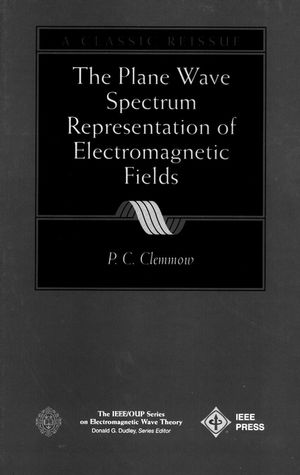The Plane Wave Spectrum Representation of Electromagnetic Fields: (Reissue 1996 with Additions)ISBN: 978-0-7803-3411-3
Hardcover
868 pages
September 1996, Wiley-IEEE Press
 This is a Print-on-Demand title. It will be printed specifically to fill your order. Please allow an additional 10-15 days delivery time. The book is not returnable.
|
||||||
I. PRELIMINARIES.
1.1. Objective.
1.2. Maxwell's Equations.
1.3. Fourier Integral Analysis.
II. PLANE WAVE REPRESENTATION.
2.1. Plane Waves.
2.1.1. Homogeneous Plane Waves in Vacuum.
2.1.2. Inhomogeneous Plane Waves in Vacuum.
2.1.3. Plane Waves in an Isotropic Medium.
2.1.4. Plane Waves in an Anisotropic Medium.
2.1.5. An Example.
2.2. Angular Spectrum of Plane Waves.
2.2.1. Plane Surface Currents.
2.2.2. Angular Spectrum in Vacuum: Two-dimensional Case.
2.2.3. Simple Examples: Line-sources.
2.2.4. Angular Spectrum in Vacuum: Three-dimensional Case.
2.2.5. Simple Example: Dipole Source.
2.2.6. Angular Spectrum in an Anisotropic Medium.
III. SUPPLEMENTARY THEORY.
3.1. Radiated Power.
3.1.1. The Two-dimensional Case.
3.1.2. The Three-dimensional Case.
3.2. The Radiation Field.
3.2.1. Heuristic Approach: Stationary Phase.
3.2.2. Rigorous Approach: Steepest Descents.
3.3. Angular Spectrum with Simple Pole.
3.3.1. The Complex Fresnel Integral.
3.3.2. Reduction to Fresnel Integral.
3.3.3. Steepest Descents with Saddle-point Near a Pole.
3.4. Relation to other Representations.
3.5. Gain and Supergain.
PART II. APPLICATION.
IV. DIFFRACTION BY A PLANE SCREEN.
4.1. Black Screen.
4.1.1. Formulation of the Problem.
4.1.2. The Half-plane.
4.1.3. The Slit.
4.2. Perfectly Conducting Screen.
4.2.1. Babinet's Principle and the Cross-section Theorem.
4.2.2. The Half-plane.
4.2.3. The Wide Slit.
4.2.4. The Narrow Slit.
4.2.5. Line-source.
V. PROPAGATION OVER A UNIFORM PLANE SURFACE.
5.1. Radio Propagation over a Homogeneous Earth.
5.1.1. Reflection Coefficients for Plane Wave Incidence.
5.1.2. Solution for a Localized Source: J5-polarization.
5.1.3. Solution for a Localized Source: jET-polarization.
5.1.4. Special Cases.
5.2. Surface Waves.
5.2.1. Reactive Surfaces.
5.2.2. Generation of a Surface Wave.
5.2.3. Launching Efficiency.
VI. PROPAGATION OVER A TWO-PART PLANE SURFACE.
6.1. Perfectly Conducting Half-plane on Surface of Semi-infinite Homogeneous Medium.
6.1.1. Genesis and Nature of the Problem.
6.1.2. Solution for Incident Plane Wave: If-polarization.
6.1.3. Solution for Line-source: if-polarization.
6.1.4. Reduction of the Solution.
6.1.5. Special Cases.
6.2. Two-part Impedance Surface.
6.2.1. Solution for Incident Plane Wave: -polarization.
6.2.2. The Split of sin ft + / sinhy.
6.2.3. Surface Wave Reflection and Transmission.
VII. THE FIELD OF A MOVING POINT CHARGE.
7.1. Motion in a Plane.
7.1.1. General Formulation.
7.1.2. Periodic Motion: Uniform Circular Motion.
7.2. Uniform Rectilinear Motion.
7.2.1. Motion in a Vacuum.
7.2.2. Motion in a Dielectric: Cerenkov Radiation.
VIIL SOURCES IN ANISOTROPIC MEDIA.
8.1. Uniaxial Medium.
8.1.1. The Dielectric Tensor.
8.1.2. Surface Currents in Plane Normal to Axis.
8.1.3. Dipole Normal to Axis.
8.1.4. Surface Currents in Plane Parallel to Axis.
8.1.5. Dipole Parallel to Axis.
8.1.6. Point Charge in Uniform Motion Parallel to Axis.
8.1.7. TE and TM Resolution.
8.2. Magneto-ionic Medium.
8.2.1. Surface Currents in Plane Normal to Magnetostatic Field.
8.2.2. Surface Currents in Plane Parallel to Magnetostatic Held.
8.2.3. Point Charge in Uniform Motion Parallel to Magnetostatic Field.
ANNOTATED BIBLIOGRAPHY.
INDEX.



